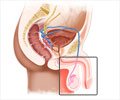Blood test to help predict who may be at increased risk and who may be at lower-than-average risk for spontaneous preterm delivery has been developed.

‘Preterm birth can result from several conditions, including preterm labor, preterm rupture of the placental membrane, or preeclampsia.’





In a paper published in the American Journal of Obstetrics & Gynecology, the team presents results from a multicenter study showing that five circulating microparticle proteins found in first-trimester blood samples may provide important clues about risk of spontaneous preterm birth. "A lot of the issues in pregnancy that result in spontaneous preterm birth begin at the end of the first trimester when the placenta becomes vascularized," said corresponding author Thomas McElrath, MD, PhD of the Division of Maternal-Fetal Medicine in the Department of Obstetrics and Gynecology at the Brigham. "Our goal is to develop prognostic markers for our patients to help make predictions and, ultimately, help us tailor treatment to the individual and offer highly personalized care to every woman from early on in her pregnancy."
McElrath and colleagues have found that proteins contained in circulating microparticles in the blood may hold important clues about spontaneous preterm birth. Circulating microparticles (CMPs) are tiny packages secreted by cells that can contain proteins, RNAs and other molecules that act as messages that can be transmitted from one cell to another. This form of cell-to-cell communication has largely been studied in cancer, but McElrath and others have wondered if CMPs have their evolutionary roots in the highly orchestrated but mysterious process of placental implantation. Proteins found in CMPs can be detected in blood samples from patients, making them a fairly straightforward readout--or biomarker--to study. In previous studies conducted by McElrath and colleagues, the team identified a group of five promising proteins that they hypothesized might predict preterm birth.
To validate this concept, the team leveraged blood samples collected toward the end of the first trimester of pregnancy from three established biobanks in Seattle, Boston and Pittsburgh. The team compared samples from 87 women who delivered at or before 35 weeks to samples from 174 women who delivered at term and were the same age and at the same week of pregnancy at the time of the blood draw.
The team analyzed multiple CMP associated proteins but found that a subset of these proteins could help predict risk both for mothers who had previously given birth and for first-time mothers. For first-time mothers, if a woman's risk of spontaneous preterm delivery was 4.9 percent, a positive test result suggested a risk of 20 percent while a negative result reduced this to a 2 percent risk.
Advertisement
Currently, there is no treatment or prevention for spontaneous preterm birth, but McElrath hopes that prognosis will serve as an important first step toward therapy, particularly as investigators gain insights into its biological causes.
Advertisement
Source-Eurekalert















